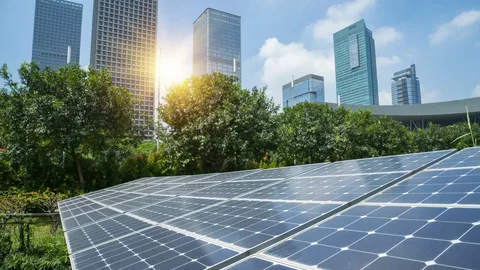
Climate change is probably the largest issue the world is currently dealing with. From increasing global temperatures and shrinking ice caps to weather extremes and sea level rise, the impacts are becoming increasingly difficult to disregard. The principal cause of climate change is the emission of greenhouse gases (GHGs) such as carbon dioxide (CO₂) into the atmosphere.
These gases are primarily a result of the combustion of fossil fuels such as coal, oil, and natural gas to generate electricity, fuel automobiles, and fuel industries. While nations across the globe attempt to discover cleaner and more sustainable means of generating energy, solar energy has become one of the most potent weapons in the battle against climate change.
Solar power is a renewable and clean source of energy which uses the energy of the sun’s rays to generate electricity. Solar power is devoid of any harmful emissions or pollutants such as fossil fuels. Solar panels, or photovoltaic (PV) panels, harness solar power to generate electricity without emitting CO₂ or other greenhouse gases. Solar power, thus, is a green and clean source of energy that can restrict the world’s dependence on fossil fuels as well as the carbon footprint of energy generation.
One of the most powerful advantages of solar power is that it is abundant. The sun powers the planet with more energy in one hour than the entire world uses in a year. This means that solar power has the potential to provide the world’s energy needs several times over if harnessed in its optimal form.
Germany, China, the United States, and India have all made gigantic leaps in solar power utilization, building massive solar farms and encouraging rooftop installations. These measures not only reduce GHG emissions but also lower energy costs and create thousands of green-collar jobs.
The international influence of solar energy is already being seen. Solar electricity is the world’s fastest-expanding source of electricity, as stated by the International Energy Agency (IEA). Solar and wind together produced more than 12% of world electricity in 2023, and the trend is increasing every year.
As more solar systems are installed, the amount of fossil fuel burned will decrease, leading to lower emissions and cleaner skies. The shift is necessary in reducing the increase in world temperatures and achieving the climate targets of the Paris Agreement.
Besides reducing carbon emissions, solar power also contributes to environmental conservation in several ways. Solar power, for example, requires significantly less water than coal or nuclear facilities, which consume vast quantities of water for cooling purposes. This makes solar power highly beneficial in regions likely to experience water scarcity. Solar panels can also be incorporated into already constructed areas such as rooftops, car parks, and highways, thereby reducing the necessity of having to destroy natural habitats or clear forests to generate electricity.
Again, another significant feature of solar power is its contribution to access to energy and social development. There are millions of people in much of the world, particularly rural Africa and South Asia, who do not have access to clean electricity. Solar home systems and mini-grids are offering clean and inexpensive energy to such people, enhancing welfare, empowering education, and enabling small businesses. Such decentralized energy access not only alleviates poverty but also causes development to occur without increasing greenhouse gas emissions.
But as much as solar energy has so many benefits, it also has its drawbacks. Solar panels are not produced without the mining of raw materials like silicon, silver, and rare earth elements, which, if not properly managed, have social and environmental implications. Second, the recycling problem of solar panels also is quickly emerging as a major challenge because more systems are entering their end-of-life. For the complete climate potential of solar energy to be realized, these challenges must be addressed through better manufacturing practices, circular economy practices, and strong recycling systems.
Conclusion
In brief, solar power is the essence of climate change mitigation. Replacing fossil fuels with a clean and renewable source of energy, solar power minimizes the emission of greenhouse gases, fights air pollution, saves water, and encourages global sustainable development.
It allows developed and developing nations to shift to a low-carbon economy while at the same time attaining economic development and energy security. The benefits of solar power to the world cannot be questioned despite the challenges that must be addressed.
Investment in solar technology, upgrading infrastructure, and encouraging its usage at all levels will be the secret to attaining a cleaner, healthier, and sustainable world for the next generation.





